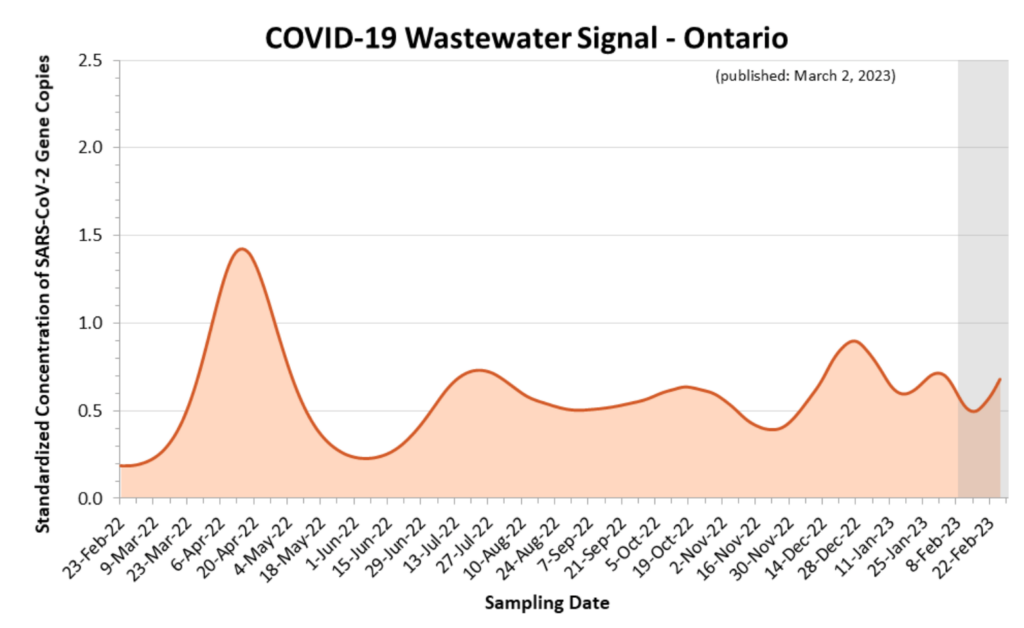It's March, 2023. Most of the world has "moved on from COVID" and stopped wearing masks. Here at York University, the YUScreen system was dropped last month and many of the door signs about COVID have been removed. But the fact remains that there are still plenty of reasons to wear a mask* in public.
First, COVID is still here. It's still airborne and it's still dangerous. The wastewater data tells us that's it's widespread, and the coughing you keep hearing in your kid's school, on the bus and in the cubicle next to you at work is all the additional anecdotal evidence that you need to confirm it.

Second, there are other reasons for wearing masks. Not only are there other airborne nasties, but pollution is pretty bad in places like the Toronto subway system.
And, because the demand for N95s has decreased, you can buy some for cheaper than before -- a really important deal with all the inflation going on. The side benefit to less expensive masks is that you can now buy a variety of them and figure out which ones that fit you best while also maximizing comfort.
While you can do an official fit test or do an unofficial DIY one at home, many of us are experienced enough at this point to be able to feel when a mask is leaking and so should do our best to find the best-fitting, most comfortable mask possible, regardless of fit test.
Way before COVID, Dr. Lisa Brosseau did a study to see if "naive" users could wear an N95 effectively. The answer is yes. The seals weren't perfect, but they were better than the result with alternative face coverings like surgical masks. The study, published in 2010, was entitled "Fit Testing Respirators for Public Health Emergencies".
It's important to note that there are plenty of people for whom N95 wearing is a challenge because of face size or shape. While I like to wear a PrescientX [breathe] respirator in class and on the subway, I also wear a disposable 3M VFlex N95 and find that it fits me better than a 3M Aura. My wife finds the smaller Vitacore CAN99 N95 respirator a better fit, but I find that it's too small for my face. Your experience will vary from others and so it's important that you try to find the mask that works for you. To help with that some vendors have "sampler" packs:
- DonateAMask's sampler packs. (most of these are official N95 with ear-loops)
- CanadaStrong's sampler pack. (ear-loop, KN95 style)
You can also often get sale prices at online vendors like United Canada. Some stores will sell you individual N95s (like Toronto's Starkman's).
In these times of self-contradictory "individual" public health, we need do a better job of looking out for ourselves and one another. Do you best with your mask.

James Andrew Smith is a Professional Engineer and Associate Professor in the Electrical Engineering and Computer Science Department of York University's Lassonde School, with degrees in Electrical and Mechanical Engineering from the University of Alberta and McGill University. Previously a program director in biomedical engineering, his research background spans robotics, locomotion, human birth and engineering education. While on sabbatical in 2018-19 with his wife and kids he lived in Strasbourg, France and he taught at the INSA Strasbourg and Hochschule Karlsruhe and wrote about his personal and professional perspectives. James is a proponent of using social media to advocate for justice, equity, diversity and inclusion as well as evidence-based applications of research in the public sphere. You can find him on Twitter. Originally from Québec City, he now lives in Toronto, Canada.
Note: I am not an HVAC, PPE or public health expert. While I have an engineering background (degrees in both EE and MecE) and have done work in Biomedical Engineering, I am not formally trained in either HVAC, PPE or public health. If you're looking for professional design or testing advice or services, please hire a professional engineer who is an expert in the area of interest.
Conflicts of interest: none that I am aware of. I do not work for or have financial interest in any PPE, HVAC or public health company or agency. While I have communicated with companies and employees at PPE and HVAC companies, I do not work for any, nor have I received money or contracts from them. All products that I have received were paid for either personally or through my employer or were acquired through friends or family (none of which work for a PPE or HVAC company to my knowledge) -- none have been donated or loaned to me by manufacturers, suppliers or distributors.
- Mask: I'm using the colloquial term here. A proper N95 is officially a respirator. In this blog, I advocate that you wear an N95 respirator (with the headband) whenever possible. Alternatives that look like an N95 but have ear-loops aren't as good, but are better than surgical or cloth masks. Do your best. None of this is official workplace health and safety advice because I'm not qualified to tell you how or when to wear an N95 in an employer-required, OHSA-type context. When in doubt, talk to your employer. But if your employer tells you "Don't wear an N95 because you don't work in a context that requires an N95 or a fit-test for an N95" then you're on you're own and you should consider whatever option works best for you, since your employer isn't being helpful.
